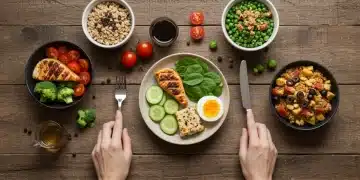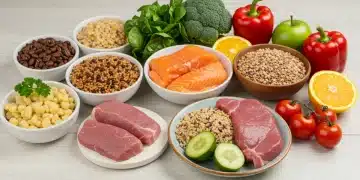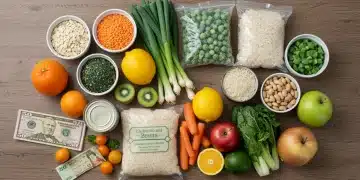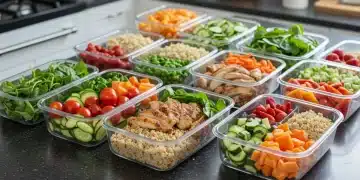Eating Healthy on the Go: Low-Cost Options for Busy Professionals 2025
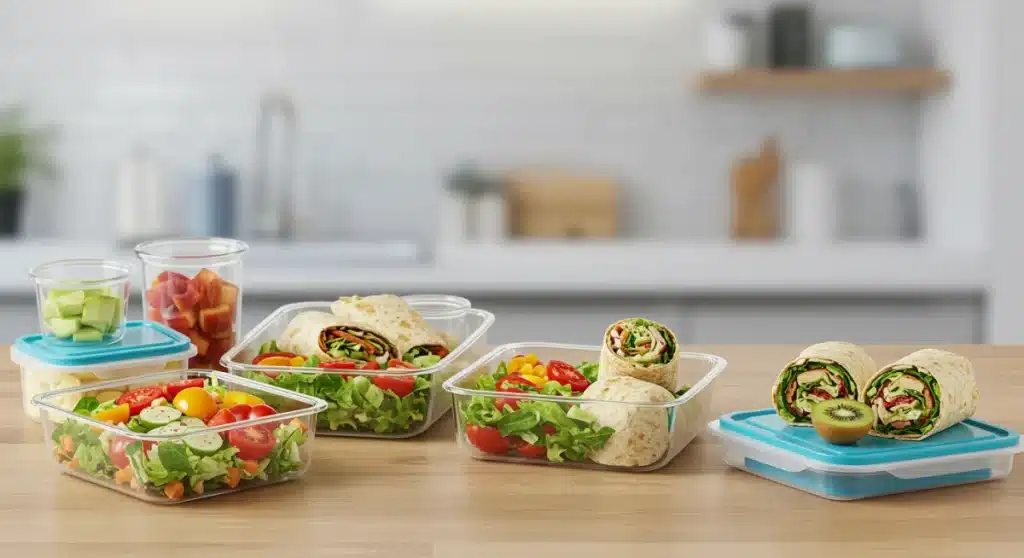
Busy professionals often struggle with healthy eating on-the-go due to time and cost constraints; this article explores five low-cost, practical options to maintain a nutritious diet without compromising financial stability or professional demands in 2025.
For many busy professionals, the challenge of balancing demanding careers with a commitment to well-being often leads to a compromise on nutrition. The quest for eating healthy on-the-go can seem daunting, especially when considering both time and financial constraints. However, maintaining a nutritious diet doesn’t have to break the bank or consume precious hours. This guide will explore five low-cost, practical options designed to empower professionals to make smart, healthy food choices in 2025, without sacrificing their budget or their schedule.
The High Cost of Convenience: Why Healthy Eating On-the-Go is a Challenge
In the fast-paced world of 2025, convenience often comes at a premium, especially when it pertains to food. Busy professionals frequently find themselves relying on readily available but often overpriced and unhealthy options, leading to both financial strain and nutritional deficiencies. Understanding the root causes of this challenge is the first step toward developing sustainable solutions.
The allure of drive-thrus, pre-packaged meals, and restaurant lunches is strong for those with limited time. While these options offer immediate gratification, their cumulative cost and nutritional impact can be significant. Many convenient food items are laden with unhealthy fats, sugars, and sodium, contributing to long-term health issues and a depletion of energy levels crucial for professional performance. Furthermore, the rising cost of living means that every dollar spent on food needs to be optimized for both value and health.
Understanding the Financial Leakage
Many professionals underestimate the financial impact of daily food purchases. A $10-15 lunch five days a week quickly adds up to $200-300 a month, or $2,400-$3,600 annually. This substantial sum could be redirected towards savings, investments, or other essential expenses. Recognizing this ‘financial leakage’ is key to motivating a shift towards more cost-effective healthy eating habits.
- Hidden Costs: Beyond the sticker price, consider the cost of potential health issues from poor nutrition.
- Time vs. Money: The perceived time-saving from convenience often masks its true financial burden.
- Budget Erosion: Small, frequent purchases can significantly erode a monthly budget without conscious tracking.
The challenge of eating healthy on-the-go is multifaceted, encompassing not just dietary choices but also financial planning and lifestyle management. By acknowledging these obstacles, professionals can better prepare themselves to embrace more sustainable and beneficial eating patterns that support both their health and their wallets. The goal is to transform what seems like an unavoidable expense into an opportunity for savings and improved well-being.
Meal Prepping: The Ultimate Budget and Time Saver
Meal prepping stands as a cornerstone strategy for anyone looking to master eating healthy on-the-go without overspending. This practice involves dedicating a few hours, typically on a weekend, to prepare meals and snacks for the upcoming week. The benefits extend far beyond just cost savings, encompassing improved nutritional intake, reduced decision fatigue, and greater control over ingredients.
The concept is simple: cook in bulk, portion out meals, and store them for easy access. This eliminates the daily scramble to find something healthy and affordable, preventing impulsive purchases of less nutritious, more expensive options. By planning meals in advance, professionals can make informed choices about ingredients, ensuring a balanced diet rich in whole foods, lean proteins, and complex carbohydrates.
Strategic Shopping for Meal Prep
Effective meal prepping begins with strategic grocery shopping. Creating a detailed shopping list based on your weekly meal plan helps to avoid unnecessary purchases and ensures you have all the required ingredients. Focusing on seasonal produce, bulk grains, and versatile proteins like chicken, beans, or lentils can significantly reduce costs. Comparing prices and utilizing store loyalty programs also contribute to maximizing savings.
- Bulk Buying: Grains, nuts, seeds, and certain proteins are cheaper when bought in larger quantities.
- Seasonal Produce: Fruits and vegetables are more affordable and flavorful when in season.
- Cost-Effective Proteins: Eggs, lentils, chickpeas, and frozen chicken breasts offer excellent protein at a lower price point.
Investing in quality reusable containers is also a smart move, as it reduces waste and keeps meals fresh. Meal prepping transforms the daunting task of healthy eating into a streamlined, efficient process, offering a powerful solution for busy professionals aiming to eat well and save money. It’s an investment of time that pays dividends in both health and financial stability.
Smart Snacking Solutions: Fueling Your Day Affordably
Beyond main meals, smart snacking plays a crucial role in maintaining energy levels and preventing overeating, especially for professionals with demanding schedules. However, convenience store snacks are often high in sugar, unhealthy fats, and artificial ingredients, not to mention their inflated prices. Developing a strategy for healthy, low-cost snacks is essential for successful eating healthy on-the-go.
The key is to opt for whole, unprocessed foods that are easy to transport and require minimal preparation. These snacks provide sustained energy, curb hunger effectively, and contribute positively to your daily nutritional intake without draining your wallet. Thinking ahead and packing snacks from home ensures you always have a healthy option readily available, avoiding the temptation of vending machines or expensive coffee shop treats.
DIY Snack Packs for Professionals
Creating your own snack packs is a simple yet effective way to control both cost and ingredients. These can be assembled at the beginning of the week, similar to meal prepping, and stored for easy grab-and-go access. Consider combinations that offer a balance of protein, healthy fats, and fiber to keep you feeling full and focused.
- Nut & Seed Mixes: Create custom mixes with almonds, walnuts, pumpkin seeds, and a few dried cranberries.
- Fruit & Veggie Sticks: Pre-cut carrots, celery, bell peppers, and apple slices paired with a small container of hummus or peanut butter.
- Hard-Boiled Eggs: An excellent source of protein, easy to prepare in advance and highly portable.
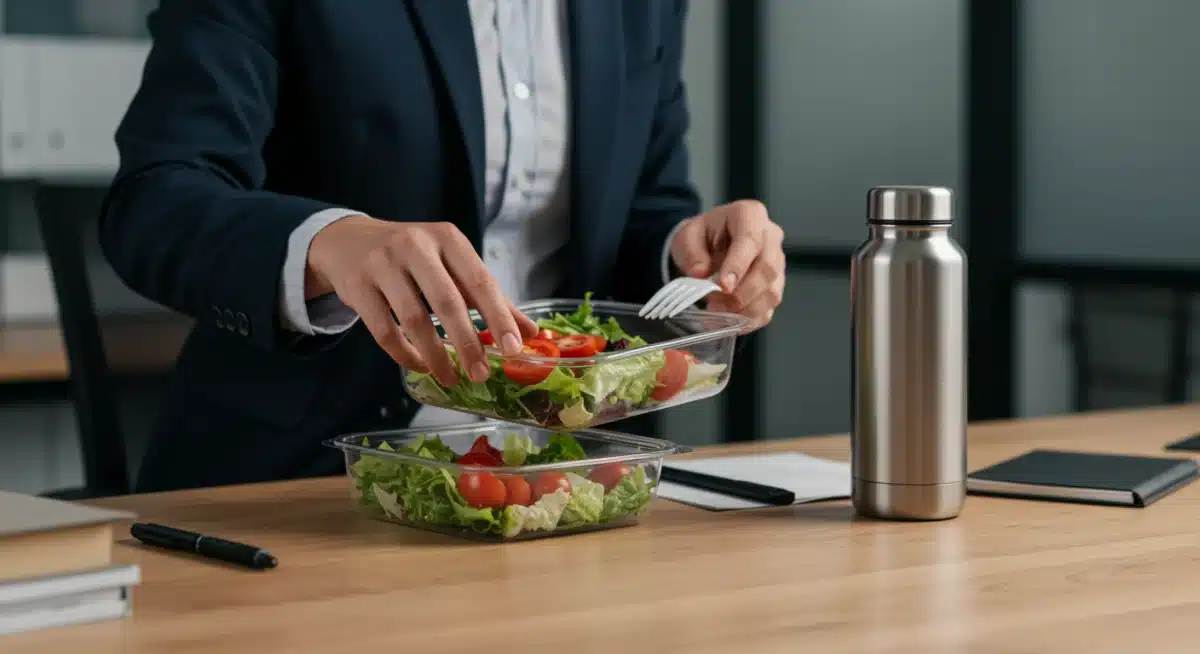
Yogurt with a sprinkle of granola or a piece of fruit, rice cakes with avocado, or even small portions of leftovers from dinner can also serve as fantastic, budget-friendly snack options. By prioritizing homemade, wholesome snacks, busy professionals can sustain their energy throughout the day, support their health goals, and significantly reduce food expenses, making healthy eating on-the-go an achievable reality.
Embracing Leftovers: Your Next Day’s Gourmet Meal
One of the most overlooked yet incredibly effective strategies for eating healthy on-the-go at a low cost is embracing leftovers. Transforming dinner into tomorrow’s lunch is not only economical but also a significant time-saver, eliminating the need for additional cooking or purchasing lunch during a busy workday. This approach maximizes the value of your groceries and minimizes food waste, contributing to both your financial well-being and environmental sustainability.
The trick to successful leftover utilization is thoughtful dinner planning. When preparing evening meals, simply cook a larger portion than needed for one sitting. Many dishes, such as stir-fries, pasta salads, soups, stews, and roasted vegetables with protein, taste even better the next day as flavors meld. Proper storage is crucial to ensure freshness and safety; investing in airtight containers is a wise decision.
Creative Leftover Transformations
Sometimes, simply reheating the same meal can feel uninspired. With a little creativity, leftovers can be transformed into entirely new and exciting dishes, adding variety to your week. This prevents meal fatigue and keeps your healthy eating journey interesting.
- Stir-fry to Wrap: Turn leftover stir-fry into a delicious whole-wheat wrap or lettuce cup.
- Roasted Veggies & Protein to Salad: Combine roasted chicken and vegetables with fresh greens for a vibrant salad.
- Soup to Grain Bowl: Use leftover soup as a base for a hearty grain bowl with quinoa or brown rice.
By viewing dinner preparation as an opportunity to create two meals instead of one, professionals can significantly cut down on their daily food expenditures. This strategy not only promotes healthy eating habits by ensuring home-cooked, nutritious options are always available but also instills a sense of resourcefulness and financial prudence. Embracing leftovers is a simple yet powerful hack for any busy professional committed to a healthy and budget-friendly lifestyle.
Hydration and Healthy Beverages: Beyond Just Water
While water is undoubtedly the best and cheapest form of hydration, focusing solely on it might miss an opportunity to enhance your eating healthy on-the-go strategy with other low-cost, beneficial beverages. Many professionals spend a significant amount on daily coffee shop runs or sugary drinks, which not only add empty calories but also quickly deplete a budget. Smart beverage choices can contribute to overall health and financial savings.
The goal is to replace expensive, unhealthy drink habits with more economical and nutritious alternatives. Preparing beverages at home and carrying them in reusable bottles or thermoses is a simple switch that yields substantial benefits. This approach gives you control over ingredients, allowing you to avoid excessive sugars, artificial flavors, and preservatives commonly found in commercial drinks.
Budget-Friendly Hydration Boosters
Beyond plain water, several low-cost options can add flavor, nutrients, and variety to your daily fluid intake without breaking the bank. These alternatives are easy to prepare and can be customized to your taste preferences.
- Infused Water: Add slices of cucumber, lemon, mint, or berries to your water for a refreshing, natural flavor boost.
- Homemade Iced Tea: Brew your favorite tea at home, let it cool, and add ice. Herbal or green teas offer health benefits and can be enjoyed unsweetened.
- Coffee from Home: Invest in a good coffee maker and brew your own coffee. The cost per cup is dramatically lower than buying from a cafe.
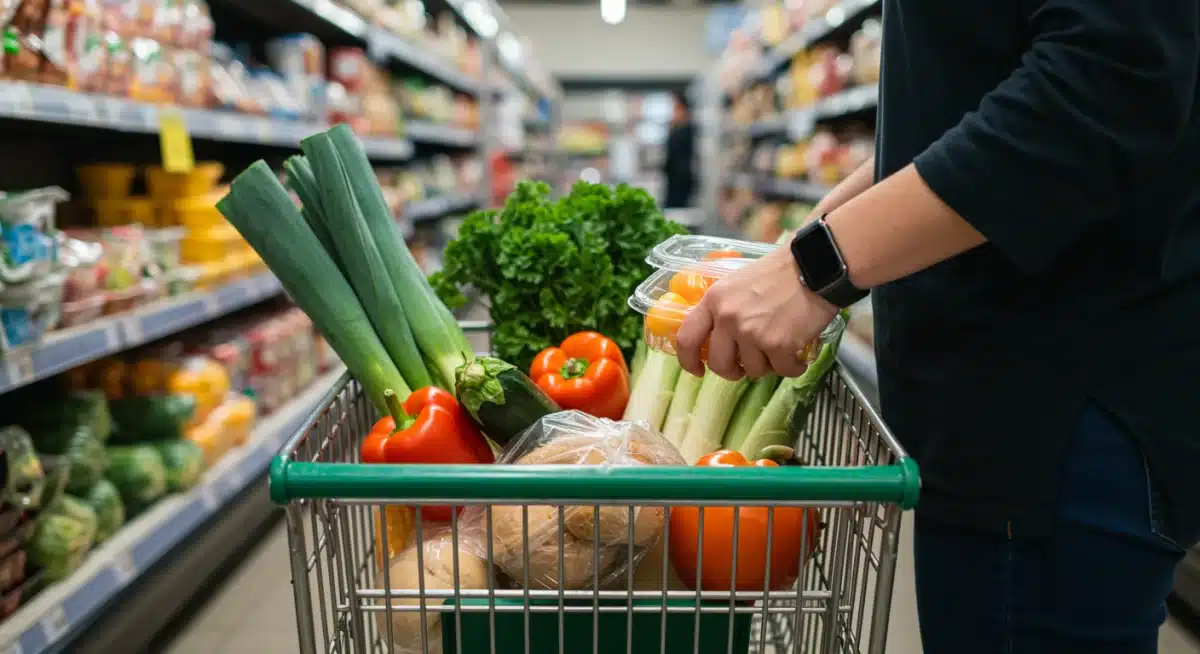
Smoothies, when made with affordable ingredients like frozen fruits, spinach, and a liquid base like water or unsweetened almond milk, can also serve as a nutritious and filling snack or even a light meal. By consciously choosing to prepare your own beverages, busy professionals can significantly reduce their daily expenses while simultaneously improving their hydration and overall dietary quality. This seemingly small change can have a considerable positive financial impact over time.
Leveraging Technology and Community Resources for Savings
In 2025, technology offers numerous tools to support eating healthy on-the-go efficiently and affordably. From meal planning apps to grocery comparison platforms, digital resources can empower busy professionals to make smarter food choices and maximize their savings. Additionally, community resources, often overlooked, can provide valuable access to fresh, affordable produce and cooking education.
Utilizing technology to plan meals, track expenses, and find deals can streamline the entire process of healthy eating. Apps designed for meal planning can suggest recipes based on ingredients you have, minimize food waste, and even generate shopping lists. Grocery store apps and websites often feature digital coupons and weekly specials that can lead to significant savings. This digital assistance transforms the often-cumbersome task of meal management into a more manageable and enjoyable experience.
Digital Tools for Savvy Eaters
Integrating these technological aids into your routine can make a substantial difference in both your budget and your nutritional goals. They provide convenience and information at your fingertips, making healthy choices easier to implement.
- Meal Planning Apps: Utilize apps like Mealime or Paprika to organize recipes, create shopping lists, and track pantry inventory.
- Grocery Store Apps: Download apps for your local supermarkets to access digital coupons, weekly ads, and loyalty program benefits.
- Budgeting Tools: Use financial apps to track food spending and identify areas for improvement, reinforcing financial impact awareness.
Beyond digital resources, exploring local community gardens, farmers’ markets (especially towards closing time for potential discounts), and community-supported agriculture (CSA) programs can offer access to fresh, often organic, produce at lower prices than conventional supermarkets. Some communities also offer cooking classes or workshops focused on healthy, budget-friendly meal preparation. By actively seeking out and utilizing these technological and community resources, busy professionals can enhance their ability to eat healthy on-the-go, making informed decisions that benefit both their health and their financial stability in the long run.
The Long-Term Financial and Health Benefits
The commitment to eating healthy on-the-go using low-cost options in 2025 extends far beyond immediate savings; it represents an investment in long-term financial stability and overall well-being. The cumulative effect of consistently making smart food choices can lead to substantial monetary benefits and a significant improvement in quality of life. This strategic approach to nutrition is not merely about cutting costs but about building sustainable habits that support a thriving professional and personal life.
Financially, reducing daily expenditures on convenience foods frees up capital that can be allocated to savings, debt reduction, or other investments. Over time, these small daily savings compound into significant amounts, contributing to greater financial security. Beyond direct savings, a healthier diet often translates to fewer sick days, increased productivity at work, and potentially lower healthcare costs in the future, all of which have tangible economic value.
Investing in Yourself: A Holistic View
Viewing healthy eating as an investment in oneself provides a holistic perspective on its benefits. The energy, focus, and improved mood that come from a nutritious diet directly impact professional performance and personal happiness. This positive feedback loop reinforces the value of prioritizing healthy, affordable food choices.
- Increased Productivity: Better nutrition fuels better cognitive function and sustained energy throughout the workday.
- Reduced Healthcare Costs: A healthy diet can mitigate the risk of chronic diseases, leading to fewer medical expenses.
- Enhanced Well-being: Feeling good physically and mentally contributes to a higher quality of life and greater resilience to stress.
Ultimately, the strategies for low-cost, healthy eating on-the-go are not temporary fixes but foundational practices for a more balanced and prosperous life. By adopting these habits, busy professionals can confidently navigate their demanding schedules, maintain their health, and achieve their financial goals, proving that convenience and cost-effectiveness can indeed go hand-in-hand with optimal nutrition.
| Key Strategy | Financial & Health Impact |
|---|---|
| Meal Prepping | Reduces daily food expenses significantly, improves nutritional intake, and saves time during busy weekdays. |
| Smart Snacking | Prevents impulse buys, maintains stable energy levels, and avoids unhealthy, expensive processed snacks. |
| Embracing Leftovers | Maximizes grocery value, minimizes food waste, and provides ready-to-eat nutritious meals for the next day. |
| Hydration & Beverages | Cuts down on costly sugary drinks and cafe purchases, promoting better health through adequate and affordable hydration. |
Frequently Asked Questions About Healthy Eating On-the-Go
Start by choosing 1-2 simple recipes for the week, focusing on versatile ingredients. Dedicate a specific time, like Sunday afternoon, for cooking and portioning. Invest in good quality, reusable containers. Gradually increase complexity as you become more comfortable with the routine.
Excellent low-cost protein options include eggs, canned tuna or salmon, lentils, chickpeas, and frozen chicken breasts. These are versatile, affordable, and can be incorporated into various meals like salads, wraps, or grain bowls for sustained energy.
By preparing meals and snacks at home, professionals can save anywhere from $8 to $15 per day, translating to $40-$75 per week, or over $2,000 to $3,900 annually. These savings significantly impact personal finances over time.
Yes, several apps like Mealime, Yummly, and Budget Bytes offer features for meal planning, recipe discovery, and grocery list generation, often with a focus on cost-effective ingredients. These tools streamline the process of healthy eating on a budget.
Consider options like hard-boiled eggs, a handful of nuts, pre-cut fruit and vegetable sticks with hummus, Greek yogurt, or homemade trail mix. These snacks are easy to prepare in advance and provide sustained energy without a sugar crash.
Conclusion
Mastering eating healthy on-the-go as a busy professional in 2025 is not an insurmountable task but rather an achievable goal with strategic planning and a commitment to smart choices. By embracing practices like meal prepping, smart snacking, leveraging leftovers, making conscious beverage choices, and utilizing available technology and community resources, individuals can significantly impact both their health and their financial well-being. These strategies not only lead to substantial savings but also foster a more energetic, focused, and resilient lifestyle, proving that a demanding career and optimal nutrition can indeed coexist harmoniously.
